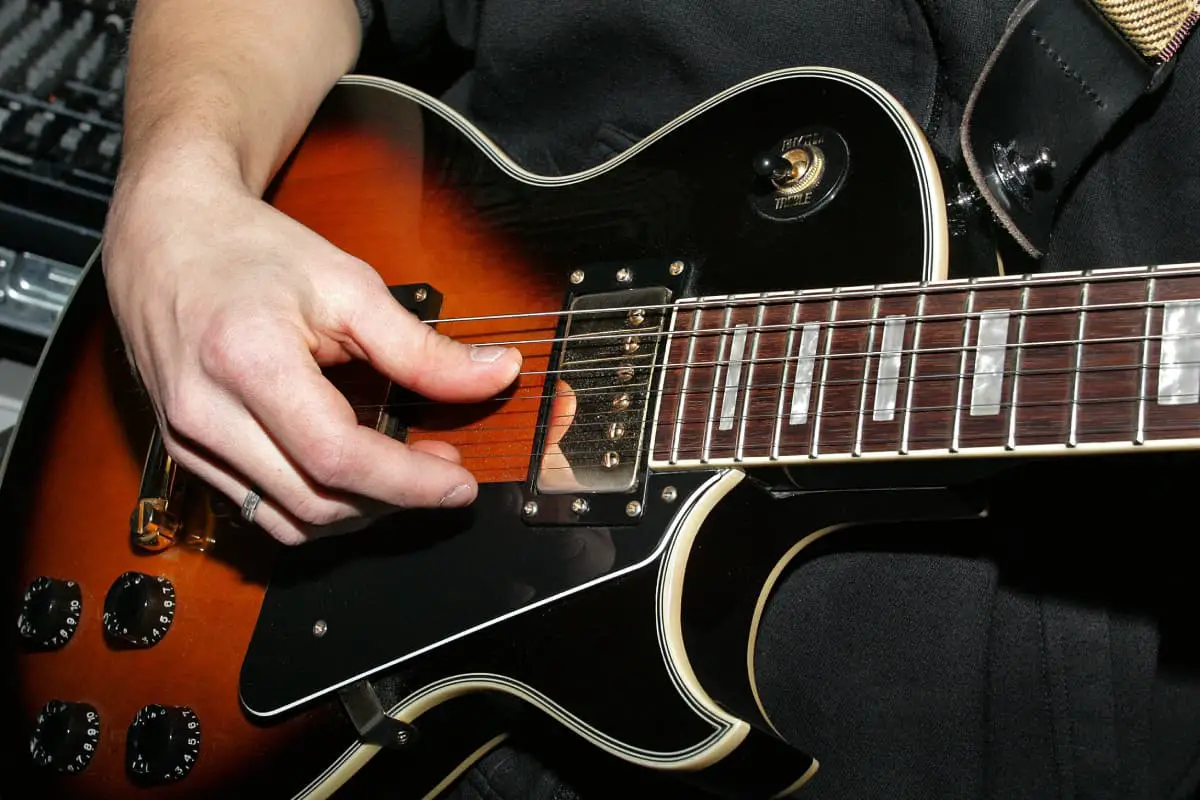Bass guitars are the cornerstone of any rock band, taking center stage in sub-heavy genres such as metal and punk. But have you ever wondered what it would sound like if your electric guitar could also function as a bass? It’s possible to turn virtually any electric guitar into bass and make it sound like one.
Here are a few ways to make your electric guitar sound more like a bass:
- Switch to thicker strings.
- Turn down your tone control knob.
- Add an amplifier to your setup.
- Adjust your amplifier settings.
- Use your Daw’s built-in bass effects.
- Use an octave pedal to switch to a lower tone.
If you’re on a tight budget and already own an electric guitar, you don’t have to spend more money on a bass guitar. In this article, I’ll show you how to make your electric guitar sound like a bass without buying an entirely new instrument or other hardware.
👇😀👇NOTE👇😀👇
If you want to find out what my recommended guitar gear is, then here is what I recommend on Amazon:
- Fender Cutaway Acoustic-Electric Guitar Bundle (MY FAVORITE GUITAR)
- Snark SN-8 Super Tight All Instrument Tuner (Easiest Tuner I’ve Used😏)
- 6 String Acoustic Guitar Capo (Best CAPO for quick changes)
- Dunlop Max Grip 1.0mm Nylon Picks (Thick Guitar Pick So You Don’t Lose Grip!)
- Universal Guitar Stand (Cheap & Minimalist Guitar Stand I Recommend)
- Levy’s 2″ Wide Quick Adjust Guitar Strap (Best Guitar Strap For Any Level)
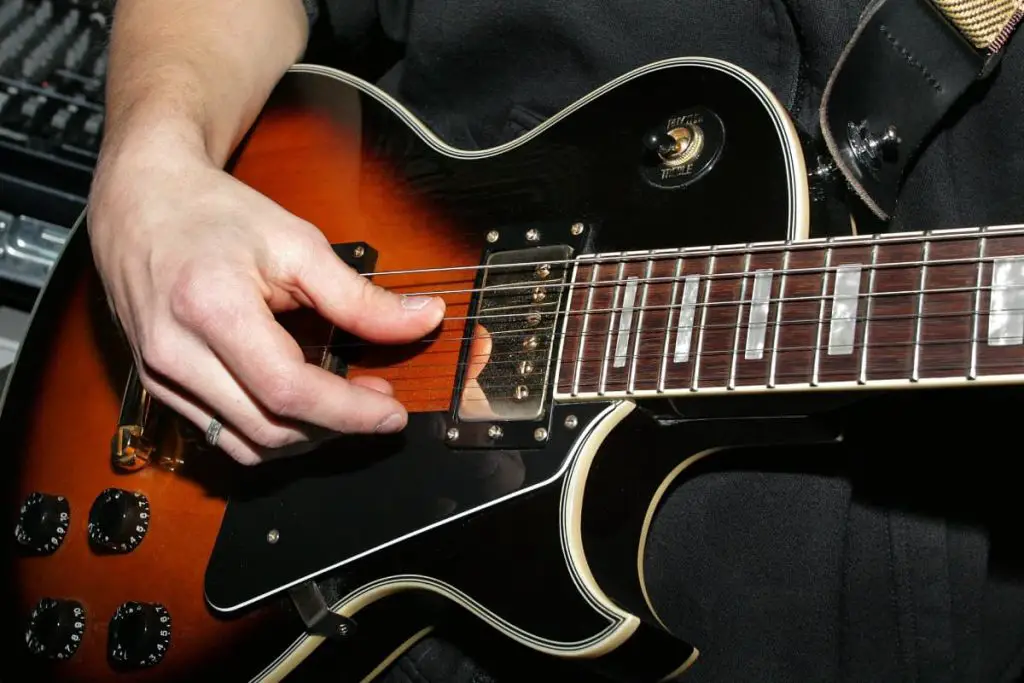
1. Switch to Thicker Strings
The thickness of your guitar’s strings determines its tone. Thicker strings produce a deeper, bass-like tone. So, instead of playing the higher strings on your guitar, focus your picking on the lower strings (EADG).
Another way to make your guitar sound like a bass is to install thicker strings on your guitar. Thicker strings give you a lower sound and make your guitar sound like a bass. The best thickness for making your guitar sound like a bass is a .040 gauge string or higher.
Pro Tip: Thicker strings require more pressure to sound good. You will have to press down on the strings harder to get a clean sound from them.
Although picking thicker strings is probably the easiest way to make your electric guitar resemble a bass, it doesn’t always yield the cleanest signal. Some parts of your song will still require higher tones that cannot be achieved by ignoring the higher strings. If you want a much more advanced way to make your ordinary electric guitar sound like a bass, check out my next trick.
2. Turn Down Your Tone Control Knob
Another way to make your guitar sound like a bass is to turn down your tone knob. Turning down your tone knob will make the highs on your guitar quieter while sustaining the mids and lows. When you turn down the tone knob, you’ll notice that your guitar will have a darker, mellow sound.
Your guitar’s tone knob controls the frequency response. It adjusts how much high frequencies (treble) and low-end frequencies (bass) pass through your signal as it leaves the guitar.
This simple control can dramatically transform your sound, allowing you to take it from bright and jangly to dark and sinister, with everything in between. Best of all, it’s easy to use – all you have to do is turn it up and down.
Tone control knobs are calibrated from 0 to 10, with zero having a minimum impact and 10 having minimal change on the tone. Lower frequencies are accentuated when the tone is turned counter-clockwise, while higher frequencies become more prominent when the knob is turned clockwise. The result is that you can choose between two different tones from the same guitar by adjusting this control.
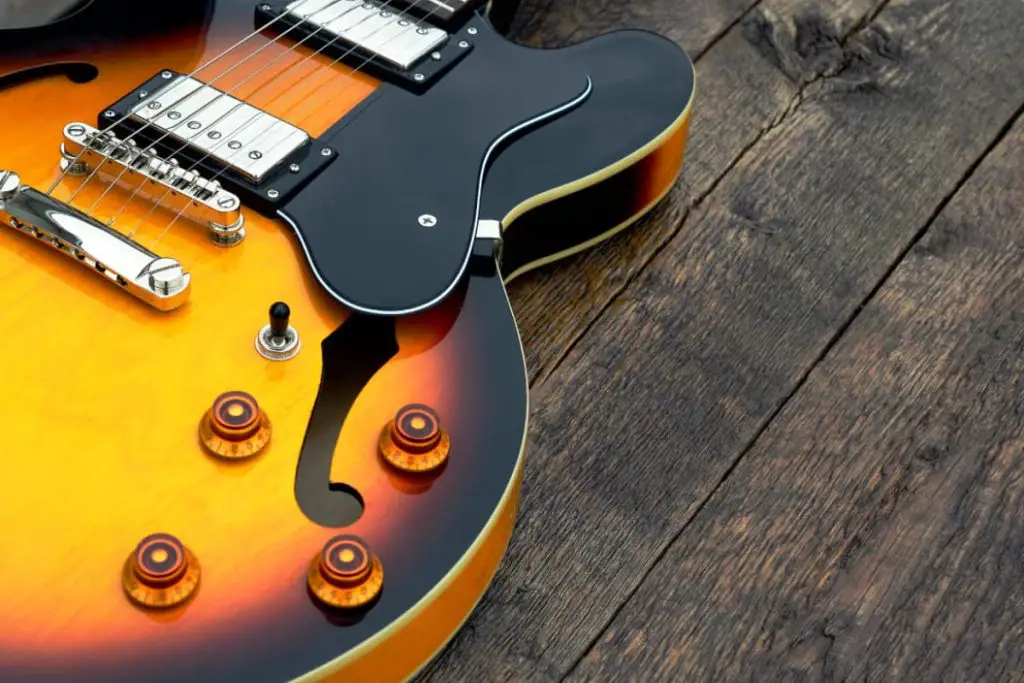
Pro Tip: Lower the volume slightly when adjusting the tone control knob. The lower frequencies you’re trying to achieve don’t come out well at extremely high volume.
3. Add an Amplifier to Your Setup
The electric guitar is a very dynamic instrument, capable of both subtlety and raw aggression. To capture the character of the electric guitar, you need an amplifier capable of delivering great clarity and a heavy crunch.
An electric guitar amp will boost the signal from your pickups and send it through pre-amp tubes before hitting the main amplification. Several different types of amps are available, including tube amps, hybrid amps, and solid-state amps. That said, how will an amplifier add to your bass?
An amplifier takes the guitar signal and boosts it (makes it louder by increasing the voltage going through the circuit). Any tone adjustments you may have added with your music processing software or tone control knob will also be boosted. The result is a cleaner output. However, you’re not done yet. Next, you need to adjust your amplifier settings.
4. Adjust Your Amplifier Settings
As you may already know, all guitar amps almost always have the same controls:
- The bass.
- The mid.
- The treble.
With these controls, a guitar amplifier can boost the signal’s low, mid, and high frequencies. You can also adjust the gain to boost the volume of the signal input with the gain control knob on your amplifier. Any other attributes included in the signal (e.g., bass plugins before amplifications will be included in the output).
The bass knob allows you to control the low frequencies in your guitar. Turning up the bass control knob should increase your bass. With the mid knob, you can easily control the mid-range frequencies in your guitar’s signal.
You’ll need to turn down the mid-range frequencies to match the low frequencies. As a rule of thumb, ensure that the mid-range frequencies never overpower the bass when attempting to turn your electric guitar into a bass.
Last but not least, don’t forget about the treble. Turning down the treble knob weakens the high frequencies in favor of the lower frequencies. However, do not turn down the treble knob completely, as it may result in muddy sounds and inaudible words.
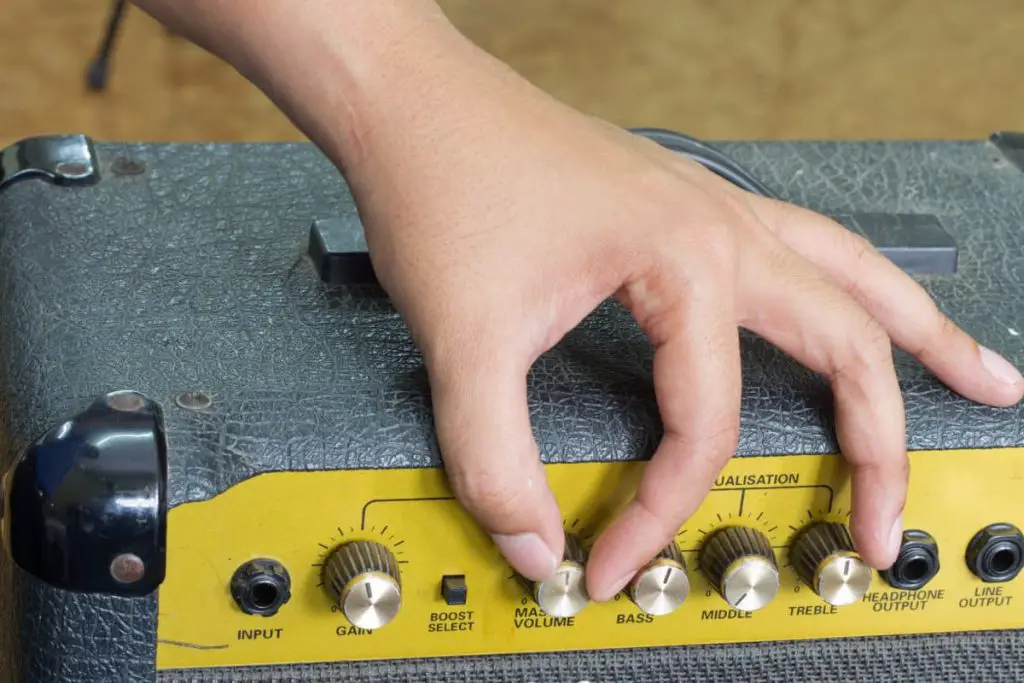
Pro Tip: Keep an eye on the bass levels in your amplifier. Too much of it could produce an output that sounds muddy or unclear. Additionally, too much bass may damage your gear if played at an extremely loud volume.
5. Use Your DAW’s Built-In Bass Effects
Old-school mixers might be handy when adding bass effects to virtually all your instruments. But, there’s a better and more convenient way to make your guitar sound like a bass: your DAW’s built-in bass effects.
Digital audio workstations (or DAWs) are programs used to record, edit, and produce audio files. These software applications have advanced features that allow the user to create, record, and produce music without the enormous expense of a real studio. Popular DAWs on the market include FL Studio, Ableton, and Logic Pro.
DAWs have several plugins that turn an audio signal into any instrument you like. That means your electric guitar’s signal can be fed into your DAW software and turned into a bass.
I’ll show you how:
- First, you must download and purchase a copy of your favorite DAW, preferably Ableton or FL Studio. However, some DAWs provide free trial features that can work in a limited capacity. Go for the free trial version if you’re not yet ready to spend on your DAW.
- Secondly, you need a way to plug your guitar into your computer. You can use a 3.5mm jack hooked to a 6.35mm stereo plug. However, an audio interface is the best way to feed your guitar’s signal to a computer without sacrificing the quality of the output. Check out different ways to plug in your electric guitar to your computer in this video. https://www.youtube.com/watch?v=G2rTi0jdUpA
- Next, download and install bass plugins on your computer. Making your electric guitar sound like a bass requires different plugins. There are many bass plugins to choose from, depending on your DAW. I recommend turning to third-party bass guitar plugins Toontrack’s EZBass, and Ample Bass Guitar.
Third-party plugins are of higher quality and produce a much more desirable output.
Recording Your Electric Guitar With Bass Plugins
With everything now set up, it’s time to record your guitar with plugins activated.
- Load the plugin on your main interface.
- Hit the record button. Some plugins come with a record button. Activate the recording button on your plugin and on the main interface.
- Start playing.
Check out how to record your guitar with plugins in this video:
Playing your guitar with plugins varies depending on your recording software. However, you may also add bass effects when mixing your recording in the final phase. DAWs often come with built-in mixers that allow you to add plugins and other effects. FL Studio allows you to organize your recordings into different tracks (multi-track recording).
Locate your guitar recording in one of the tracks and add your bass plugins when mixing. Also, don’t forget to boost the mids and cut the highs when mixing. This will bring back the warmth and roundness of your instrument while still preserving its clarity.
Pro Tip: Keep an eye on your input volume levels (gain) and avoid a clipped signal at the input stage at all costs. Clipping occurs when the input volume is too high for your equipment to handle.
6. Use an Octave Pedal To Switch to a Lower Tone
An octave pedal is a unique piece of hardware that slides your electric guitar an octave higher or lower than its original pitch. Lead guitarists have used octave pedals as part of their regular practice regimen and live performance. Unfortunately, not all players feel that the octave pedal effect can help convert the ordinary electric guitar into something more punchy.
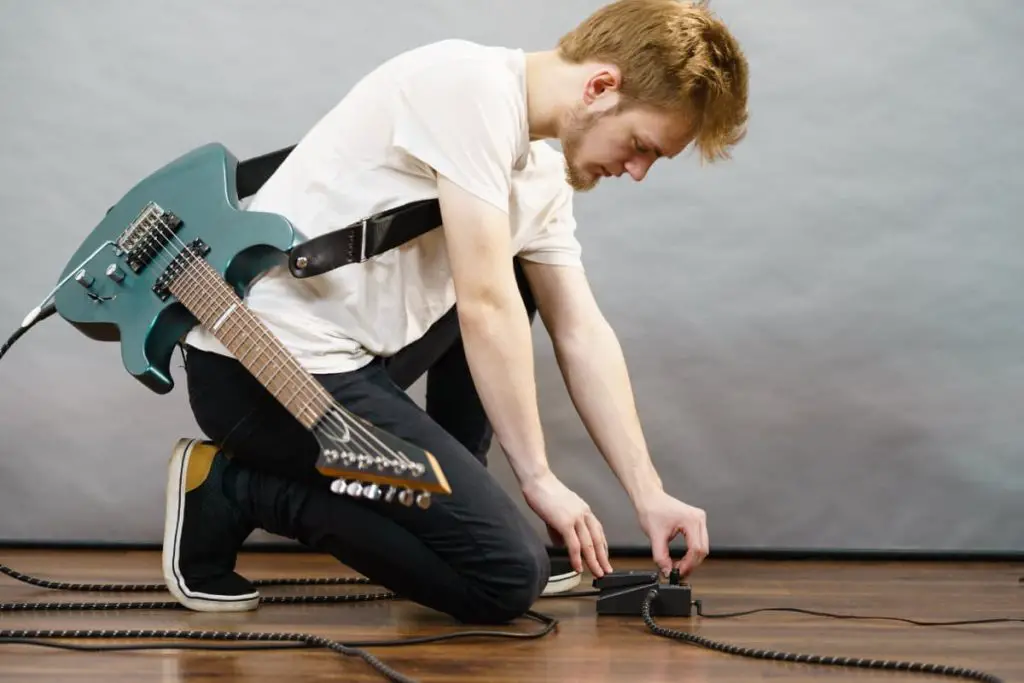
On the bright side, octave pedals are quite easy to use. All you have to do is to place yours in front of your effects chain to get the cleanest signal and start playing.
Many octave pedals promise to add layers to your track and deliver the desired effects. But, I recommend the Donner Harmonic Square Digital Octave (available on Amazon.com). This little piece of hardware is packed with multiple features, including different octave modes. You can experiment with a variety of sounds to find the perfect one for your song. Three-tone toggles (sharp, detune, and flat tone) add even more versatility, giving you 21 different sound options.
Make Any Electric Guitar Sound Like a Bass: The Dos and Don’ts
Bass guitars are tuned differently from ordinary guitars, and so many guitarists struggle while attempting to achieve convincing bass tunes from ordinary electric guitars. However, with a little practice and some innovative thinking, you can make any electric guitar sound like a bass guitar.
Here are some important dos and don’ts when it comes to making your standard electric guitar sound like a bass:
The Dos
- Switch to a slapped bass strumming style. Instead of using a fast and forceful strumming style that’s common with electric guitars, try using a slower and more relaxed approach, especially when playing bass lines. Pluck the string from below (slightly above the fretboard) and gently pull upward. Don’t forget to sustain each chord to make your playing sound as smooth and flowing as possible.
- Go easy on the strumming. Go easy on your strumming to keep your rhythm slow and relaxed. To keep your strumming relaxed, avoid rushing through your notes by taking a moment to listen through your chords. And, if you’re new to playing bass, it’s probably best to avoid trying to play too many notes at once.
- Use your thumb. Many guitarists who are transitioning to bass for the first time rely on their pick to pluck the strings. Using your thumb instead of a pick produces a mellow tone of a convincing bass.
The Don’ts
- Don’t change your guitar’s tuning. The last thing you want is to play a guitar that’s completely out of tune. Most beginners often believe that changing the tuning of their guitars is an effective way to make it sound like a bass – it’s true. The strings will vibrate at a lower frequency to give off a bass-like tune. But once you loosen up one string on your guitar, the entire instrument goes out of tune, and you have to retune it to play.
- Don’t switch out the strings and replace them with thicker bass strings. Unless you know exactly how to turn your electric guitar into a bass. Literally. Most people who choose to modify their electric guitars also have to adapt to some changes. Some chords and techniques simply won’t work or sound awkward.
- Don’t play at a deafening volume. Too much bass can put your equipment at risk of damage. Bass consumes more amp power, which means that putting too much strain on your amplifier may cause it to overheat.
If you still aren’t convinced by your instrument’s output, you’re better off with an actual bass. It may take some money out of your pocket, but on the bright side, no more stress in tweaking an ordinary electric guitar.
Unfortunately, there’s a high chance that your instrument will not sound like a real bass. That’s because of the subtle differences between electric guitars and bass guitars in the making.
Differences Between Electric Guitars and Bass Guitars
While they may look similar at first glance, these two instruments have several differences that set them apart. The electric guitar is generally the primary focus of most rock bands. However, the bass guitar is also an important instrument in any band.
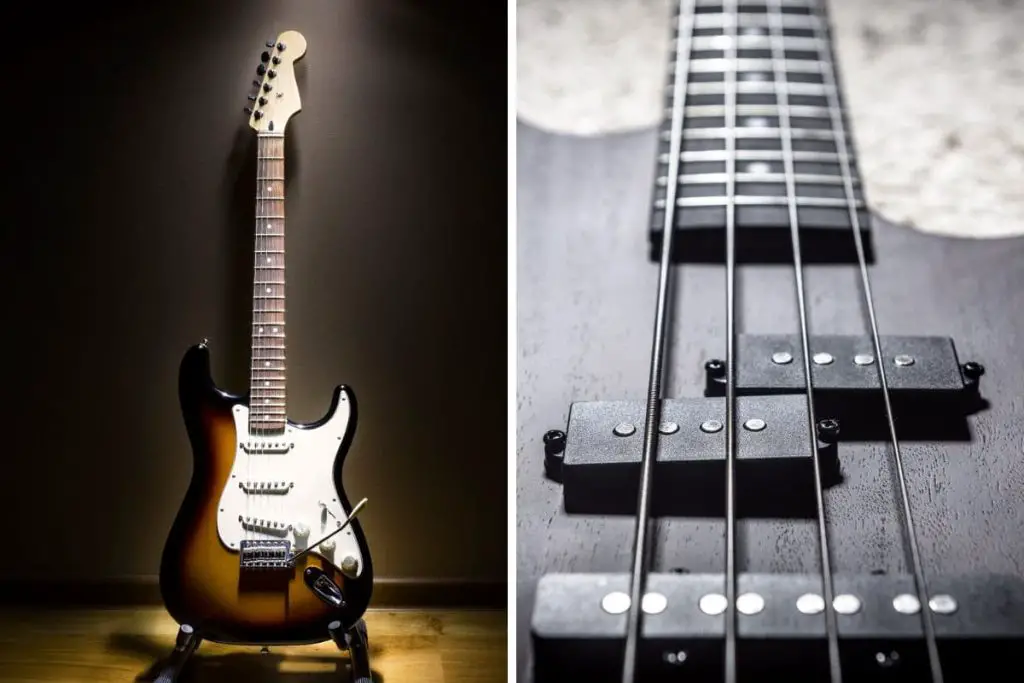
Here are a few differences that make “faking” a bass with an electric guitar more difficult than it should be:
- While most bass guitars have four strings, electric guitars have six strings. The tuning of the electric guitar is E-A-D-G-B-E, whereas that of the bass is E-A-D-G. The strings used in the bass guitar are also thicker than those used in electric guitars because thicker strings can easily sustain fuller tones.
- The strings on electric guitars are typically thinner than those on acoustic and bass guitars. Thinner strings, as you are aware, produce thinner sounds, while thicker strings produce a lower tone.
- Bass guitars have longer necks than electric guitars and are usually tuned lower. The longer strings vibrate at a lower frequency than the shorter strings of an electric guitar. Bass guitars are also heavier and produce a deeper sound than electric guitars.
- The bass guitar is designed for playing low tones, which are common in rock, jazz, and other genres of music that often feature deep and low-frequency sounds. The smaller string length and frets of an electric guitar make it ideal for playing faster and more complex melodies such as pop, rock, and heavy metal.
From what we’ve discussed, you’ve likely come to realize that each instrument has its own distinct sound, construction, and purpose. You might be drawn to the bright sound of an electric guitar, or you might be more interested in playing deep and low-register tones on a bass guitar. Either way, you’ve come to realize that each of these instruments has something special to offer.
Conclusion
Making your guitar sound like a bass may require some investment in time and money, but the trade-off is well worth it. When playing in a band, it’s good to be able to switch between guitars and basses, allowing you to cover a wider range of genres. With these tips and tricks, you can make your electric guitar sound like a bass guitar in no time.
👇😀👇NOTE👇😀👇
If you want to find out what my recommended guitar gear is, then here is what I recommend on Amazon:
- Fender Cutaway Acoustic-Electric Guitar Bundle (MY FAVORITE GUITAR)
- Snark SN-8 Super Tight All Instrument Tuner (Easiest Tuner I’ve Used😏)
- 6 String Acoustic Guitar Capo (Best CAPO for quick changes)
- Dunlop Max Grip 1.0mm Nylon Picks (Thick Guitar Pick So You Don’t Lose Grip!)
- Universal Guitar Stand (Cheap & Minimalist Guitar Stand I Recommend)
- Levy’s 2″ Wide Quick Adjust Guitar Strap (Best Guitar Strap For Any Level)
Related Posts:

